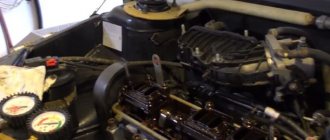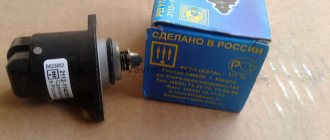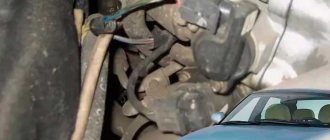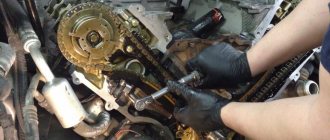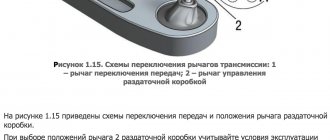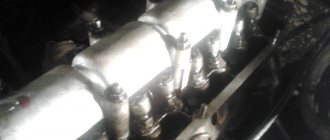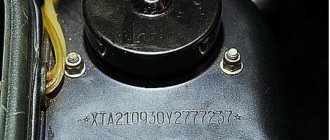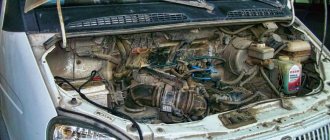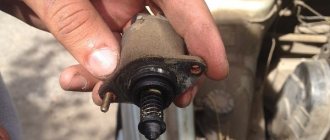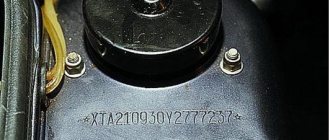The engine idles unevenly: possible reasons
There are quite a few reasons why the engine idles unevenly. Motorists should be aware of them in order to avoid unnecessary waste by solving the problem themselves and doing the repairs themselves. On the other hand, it will also be possible to avoid more serious problems thanks to timely diagnosis.
Causes of uneven engine idling
Experts divide the main reasons for rough idling into two categories:
A malfunction of the air system (intake) can be considered separately, but it is more appropriate to include it in the list of problems with the fuel system. The fact is that both of them are inextricably linked and affect the stability of the power unit in idle mode and under load.
- Fuel-air system and fuel. A poor fuel-air mixture is often the reason why the engine idles rough. Such a “poor” mixture is that there is too little fuel in it and too much air.
A more serious problem can be considered a problem with the idle air valve (also known as the idle air regulator, the secondary air regulator), which is sometimes called the idle air sensor. Owners of carburetor cars also know this part as the “solenoid valve.”
Excess air can also be sucked in through, for example, broken holes in the throttle valve axis on the carburetor. In this case, the problem may not become noticeable immediately: gasoline consumption will gradually increase, and interruptions in idling will appear.
- Poor quality fuel. Because of it, the idle speed also often “floats”. This phenomenon is especially strong when using so-called eco-gasoline. It contains a certain amount of ethanol. Ideally, this not only makes the exhaust gases less toxic, but also helps clean the fuel system.
- The fuel pressure regulator (aka low pressure bypass valve) has failed. Its task is to maintain the required fuel pressure while the engine is running in any mode.
This breakdown is indicated not only by uneven engine operation at idle, but also by interruptions if you sharply press the gas pedal, a drop in power, and a strong increase in fuel consumption.
- The injectors are clogged (the channels are coked). Due to poor operation of the injectors, the fuel mixture is of inadequate quality in composition, which leads to disruptions in the operation of the power unit in different modes and increased fuel consumption.
- Air damper malfunction. This is usually a mechanical interference, which also leads to the formation of a poor-quality fuel-air mixture. As already mentioned, this causes the engine to run unevenly.
- The idle speed on the carburetor is not adjusted. In this case, under load the engine will operate normally, but at idle it will sometimes jerk, and at the same time there may even be a slight popping sound in the muffler. A relatively simple problem that you can deal with yourself by tightening the required adjusting screw.
Electrical problems
First of all, let's start with the ignition system. More precisely, the cause is too large a gap between the electrodes on the spark plugs.
Here the symptoms will be almost the same as with poor idle speed adjustment on the carburetor. The problem can be easily resolved by reducing the gap between the electrodes.
Unstable engine operation without load can also be caused by engine tripping. That is, one of the cylinders is not working.
REASONS FOR UNSTABLE OPERATION OF MOTOR 2114
Let's consider several standard situations that can happen with an 8-valve 4-cylinder engine.
UNSTABLE OPERATION ON A COLD ICE
It often happens that a VAZ 2114 stalls when cold, but as it warms up the engine levels out and starts working stably. There could be several reasons:
- The ECU sets the fuel mixture too rich to cold;
- The spark plug does not work, but when heated, the spark plug still “breaks through”;
- The high-voltage wires are damp or moisture has entered the ignition coil;
- Parts of the piston group are worn out.
UNSTABLE OPERATION OF A HEATED ENGINE
It also happens the other way around - a cold internal combustion engine operates more or less steadily, but as it warms up it begins to throttle. Usually the engine starts when hot because:
- The cylinder head gasket has burned out;
- The ignition coil breaks;
- The engine control unit is faulty.
Engine control unit for VAZ 2114
THE MOTOR STARTS AT IDLE SPEED
Most often, a situation arises when the engine stalls at idle speed. Moreover, it makes no difference whether this happens when it’s cold or when it’s hot. There can be many reasons for this, ranging from a simple spark plug failure to malfunctions in the piston group of the internal combustion engine. While it is very easy to replace a spark plug, wear on the cylinders in the block can lead to a major overhaul.
Most often, the engine does not operate stably at idle in the following cases:
- The valves are not adjusted (clamped);
- The timing belt is installed incorrectly (the marks do not match);
- The IAC is faulty;
- The cylinder head valves are bent or burnt out (the valves can bend during a water hammer when a large amount of water gets into the air filter housing);
- The piston burned out;
- There is a malfunction in the electronic engine control system. The sensors, the ECU itself, electrical wiring and I/O wires may be to blame here.
There are many options for why the car idles at idle, but there are still the most basic ways to determine faults.
The main causes of engine vibration at idle speed
Unstable engine idling can be caused by several reasons. There are 3 (three) main reasons:
- current malfunctions in the engine itself (for example, the motor is tripping), but there can be many reasons for its “triple”;
- natural wear and tear of parts of the cylinder-piston group (CPG) during operation, when their weight begins to differ from that normalized by the manufacturer of the car (or engine);
- weakening or breakdown of parts and fastening units of the internal combustion engine.
Troit motor
An engine can fail for a variety of reasons:
- Supply system.
- Depending on the type of your internal combustion engine (diesel or gasoline/gas), depending on the type of power system (carburetor or injection), different amounts of the fuel mixture and its different composition may enter the engine cylinders. When the ignition system tries to ignite it (different in composition in different cylinders), parasitic and/or arrhythmic fires can and will certainly occur, hence the engine vibration at idle, and not only in the morning.
- Due to the natural wear and tear of engine CPG parts, different compression is formed in different cylinders over time, hence the unstable operation of the engine at idle, and not only at idle.
- Due to contamination of the jets (in a carburetor power system) or injectors (in an injection engine), a different composition of the fuel mixture can also form with a larger or smaller ratio of air volume to the amount of fuel. These are also the causes of car vibration.
- Similar reasons affect the operation of a diesel engine, especially since the ignition of the diesel fuel mixture is significantly influenced by the pressure in the fuel system, which is provided by such an important component as the high-pressure fuel pump. Experts call it that - fuel injection pump. Here are some more reasons for car vibration.
- Ignition system (for gasoline and gas internal combustion engines).
- When the engine vibrates at idle (regardless of the type of ignition, battery or electronic), the reasons often lie in “different” spark formation. Failures manifest themselves both in the spark interruption mechanisms and at the stages of its distribution among the cylinders.
- The strength (energy) of the spark itself can also depend on the condition of the ignition system components, not only at the exit from the ignition coil (or ignition coils, if there are several), but also at the electrodes of the spark plugs. This is another reason why the engine vibrates at idle. And - I repeat once again - not only at idle and/or not only in the early morning.
- Vibration in a car can also arise from the condition of the spark plugs themselves, and primarily from the size of the gap between the electrodes - central and side (or side, if the spark plug has several of them). Usually and most often the central electrode burns out. If these gaps are different on different spark plugs, even within tenths of a millimeter, and this is exactly what happens, then this parameter can also cause engine vibration.
The quality of the spark, and, consequently, the ignition mechanism of the fuel mixture, is also influenced by such factors as:
- condition of high voltage wires,
- condition of the ignition coil (or coils),
- short circuits to ground,
- high voltage breakdowns in the most diverse and unexpected places.
For these and many other reasons, the engine vibrates at idle, and not only at idle, and not only (I repeat) in the morning.
Tips for motorists
The VAZ-2114 passenger car (Samara-2) was discontinued last year, 2013. It was equipped with five injection engines, three of which (2111, 21114, 11183) had an eight-valve gas distribution mechanism (GDM), and two (21124, 21126) had a sixteen-valve timing mechanism.
Most often, drivers begin to notice that interruptions in engine operation appear at idle. Moreover, immediately after starting a cold engine, interruptions are not heard, but as soon as the engine warms up, it begins to “twitch” (twitch), and the Check Engine sign lights up on the instrument panel, requiring a diagnostic check of the engine. It is advisable to carry out diagnostics, since searching for a fault blindly may take a long time and be unsuccessful.
But it must be remembered that a possible cause of engine twitching at idle may be unadjusted timing valves, the thermal clearance of which must be checked every 20 thousand kilometers. There are cases that even on a new engine one of the valves turns out to be “pinched”, and the thermal gap will only be there while the engine is cold, but as soon as it warms up, the valve opens slightly and the engine begins to operate unstably at idle.
A possible reason for the intermittent operation of the engines (2111, 21114, 11183) of the VAZ-2114 car may be a malfunction of one of the spark plugs, poor contact of the high-voltage wire or its breakdown to ground. For engines (21124, 21126), failure of the spark plug or ignition coil. Malfunctions of spark plugs include the appearance of black carbon deposits on the insulator, as well as a large increase in the gap between the central and side electrodes.
Unstable operation of the engine can be caused by air leaks that enter the engine cylinders, bypassing the throttle assembly, which causes a lean mixture and a sharp decrease in crankshaft speed. Air leaks into the cylinders are possible due to a malfunction of the vacuum brake booster valve located in the flange to which the hose leading to the intake manifold is connected.
The injectors may also be involved in the same malfunction if the nozzle holes are completely or partially coked or, due to poor contact in its block, it does not fire every time. There may also be insufficient pressure in the fuel rail, which the fuel pump cannot create due to a clogged fuel filter or contamination of its intake chamber, the entrance to which is blocked by a fine mesh.
Reasons for "blondes"
Sometimes poor performance of the injection system is simply due to inattention to the condition of the car and untimely maintenance.
1. Filters are clogged. Replacing air and fuel filters is a mandatory part of car maintenance for experienced car owners. The average service life of filters on a VAZ is 30,000 km. The actual value depends on the quality of the fuel and the filter itself, and operating conditions. If the car has traveled more than 100 thousand kilometers, it is advisable to change the filters more often, every 10-15 thousand (or once a year). During this mileage, dirt inevitably accumulates in the system.
If your car stalls in neutral or immediately after starting the engine, start by inspecting the filters.
2. Lack of gasoline. The critical fuel level cannot be allowed. Dirt may get into the fuel line and settle at the bottom of the tank. If the gauge has reached a critical level (or does not work), the car has just been driving, and after stopping it does not start or starts and stalls, you may need to add fuel.
Firstly, the accuracy of the FLS on the VAZ is not ideal. Secondly, if you stop at a slight level on a slope, fuel may not be sucked in by the pump at all or may be mixed with air.
3. Crooked hands. If the problem appears immediately after repairing the machine, carefully check the connections of all chips or the integrity of the wires. The reasons why the engine stalls may lie there.
How to fix the problem?
After the reasons why the VAZ 2114 engine is tripping have been determined , it is necessary to act depending on the situation:
- If there are problems in the ignition system, replace the broken spark plug or high-voltage wires.
- If the reason is in the fuel injection system or compression level, clean the injectors with ultrasound, adjust or replace the valves, air filter, check the position of the timing belt.
If these actions do not lead to results, you need to check and, if necessary, replace:
- Control block;
- crankshaft position sensor;
- oxygen sensor.
Thus, engine tripping is a common breakdown that, with experience and skillful hands, can be corrected on your own. If the cause of the tripping is a breakdown in key systems (control units) or there is no special equipment at home (for example, for cleaning injectors with ultrasound), it is recommended to contact a service station.
Other causes of vibration at idle
In theoretical mechanics and in such disciplines as automobile theory and engine theory, there is simply an incredible number of causes of vibration of the engine, power plant and the entire car. These could be malfunctions of the engine itself, or malfunctions of body elements. Add to this the contamination of the fuel system with low-quality fuel at our gas stations, which entails contamination of filters and lines, malfunctions of the ignition systems, etc., etc. Add here also the quality of our roads, which loosen all the fastenings in the body - and, in the end, you will get a loose car, vibrating in all its parts. And the older he gets, the more “sausage” he gets – this is a regularity.
Motor imbalance
Before talking about the natural wear and tear of parts and assemblies of the cylinder-piston group (CPG), you should know the history of the assembly of your specific engine by the manufacturer or by mechanics at the service center if your internal combustion engine has undergone a major or even partial repair with the replacement of parts.
At most production facilities in the global automotive industry, the quality of components supplied to the assembly line is monitored very strictly, and in the elite sector and in the production of so-called high-performance engines (boosted and turbocharged), the master assembler double-checks and weighs each (every!) part on a scale before installing it into the block (or cylinder head) of the cylinders. That is why, for example, Ferrari engines can spin up to 10-12 thousand revolutions (and engines in Formula-1 cars even more), and at idle they make no louder noise than a home vacuum cleaner. If not even quieter.
And now imagine the opposite situation, when our “domestic serviceman” repairs your engine yourself, or when you buy yourself a “very used” car. When repairing an engine, a “normal motor mechanic” in a “normal car service center” is given from the warehouse 4 pistons, 4 sets of piston rings, 8 or 16 valves, plus many other components requested by him.
But a competent engine mechanic (without quotes) will take a dozen or one and a half of the same pistons from the same warehouse, weigh them all, and set aside only four for himself, but which will turn out to be very close in weight. The rest will be returned to the warehouse. And so with all components and spare parts. Such a master will first center the shafts - crankshaft and distribution shafts - in the spindle of the lathe. If he finds axial or vertical runout in one that exceeds the official tolerances, then he will definitely reject such a shaft and send it back to the warehouse.
Among other things, some internal combustion engine designs have a so-called balancer shaft, which, working in antiphase with the crankshaft, dampens vibrations and oscillations. And a competent mother will definitely double-check this detail.
But even a well-repaired engine, including a new one off the assembly line, wears out over time. The piston rings and pistons themselves wear out (and become lighter), other parts of the engine change their weight (and balancing), and some, acquiring carbon deposits and oil deposits, on the contrary, become heavier. For these reasons, there appear: vibration from the engine, vibration in the body, including sometimes even vibration of the steering wheel at idle when the car is standing (standing on the side of the road!).
What to do? The recipe is simple: to overcome all vibrations, you need to replace worn parts with new ones.
How to understand what is wrong with the VAZ-2114 engine
The concept of “engine tripling” was invented by motorists themselves. It is associated with the design and operation of four-cylinder internal combustion engines. If one of the four cylinders failed, the internal combustion engine still continued to operate on the three remaining cylinders. But such a failure was distinguished by a characteristic sound, which was called “engine tripping” - functioning on only three cylinders. In this case, the fuel mixture in the idle cylinder will not burn as expected, but will accumulate.
If you do not respond to such a failure in the system in time, the fuel mixture will be diluted with oil, enter the crankcase with oil and dilute it thinner and thinner. In this case, the oil will lose its lubricating functions, which will lead to rapid wear of the rings, cylinder-piston group and other important parts of the car. A little later, the engine will have to be repaired not partially, but completely.
Similar failures occur in the VAZ-2114. They can be recognized by their characteristic features:
- The engine in idle mode manifests itself with periodic twitching, unevenly.
- When driving, the VAZ-2114 does not gain the required power.
- The car moves jerkily.
- If you press the gas pedal, failures in engine operation will be detected.
- An uneven exhaust comes out of the muffler, which is interrupted and accompanied by popping noises.
Against the background of these signs that the VAZ-2114 engine is failing, the driver may notice an increase in fuel consumption.
Main reasons
The following reasons can lead to such a breakdown:
- low level of compression in the cylinders (for example, due to poor valve fit);
- injector contamination - the injection system is disrupted as a result of poor flow or fuel overflow;
- lack of spark supply to the spark plug - due to a malfunction of the spark plug or high-voltage wire;
- air filter contamination;
- control unit failure;
- malfunction of the crankshaft position sensor;
- change in position, or initial incorrect installation of the timing belt.
Failure of one cylinder can lead to breakdown of the entire engine. The gasoline that enters the idle cylinder does not burn out and mixes with the oil. As a result, the oil loses its properties and engine parts begin to wear out.
Engine operating principle
Engine mounts
Not many current car owners bother with this issue, and in vain! Yes, modern designs and materials of fastenings today are many times better quality than they were even 8-10 years ago, but they also wear out. These fasteners are a so-called silent block, where metal parts are “welded” in a special way with rubber and rubber-metal components. However, any rubber dries out and cracks over time, and eventually simply breaks. Over time, metal parts also acquire so-called fatigue wear. A break in the engine mount provokes significant vibrations in the body, which are fraught with very serious consequences for it.
Other breakdowns that cause interior vibration
But it’s not for nothing that the list of possible faults includes the item “Other technical flaws”. Just because some problems are more common than others doesn't mean they don't happen. That is why it is better to carry out a full diagnosis of the car when vibrations occur in the cabin.
Burnt-out diodes, pebbles and plants getting stuck in parts, friction of parts against each other, tilting of the engine and dents on the body - these are just a small part of those minor faults that can cause unpleasant trembling of the body and disrupt the operation of the engine. Fixing them doesn't take much time if you know how to do it yourself. A car service would not be the best solution. Once mechanics become aware of annoying vibrations, they may force you to replace already functioning parts.
Having bought a car, you should be prepared for the fact that you will have to learn how to understand it if you do not want to leave huge sums of money in car repair shops. This is especially true for VAZ, which likes to annoy drivers with all sorts of breakdowns, from slowly working wipers to body vibrations. You must always carefully monitor your vehicle if you do not want to stop in the middle of a busy road and cause a lot of inconvenience to others.
What to do if the engine starts to stall
8-valve injection engine VAZ 2114
In order to determine why the engine in a VAZ 2114 is misfiring, you must follow the recommendations of professionals. First of all, you need to determine which cylinder is out of order, for this you need to:
- open the hood with the engine running;
- remember the sound and nature of the operation of the power plant;
- remove the high-voltage wires from the spark plugs one by one, if the sound and rhythm of operation changes, then continue further, as soon as it is discovered that when the spark plug is de-energized, the nature of the sound does not change, which means the faulty cylinder has been identified.
Next, you need to unscrew the spark plug and determine its condition and performance.
It is unscrewed using a special spark plug wrench, which is recommended to be carried with you in an emergency kit. It takes up little space, but is a unique key that cannot be replaced and can come in handy at the most unexpected time. After all, even simply by replacing a heavily carbonated spark plug with a new one, you can temporarily solve the problem with starting the engine.
The next step is to determine the condition of the removed spark plug. If the electrode is intact and clean, and there is a large amount of soot on the head, then with a high degree of probability it can be determined that dust has entered the combustion chamber of the cylinder, therefore the fault must be looked for in the air supply system through the air filter.
If the entire head, along with the electrode, is covered in smoke, and it is severely burnt out, it means that a lean mixture was supplied and detonation combustion occurred with ignition advance. When the head is also completely covered with smoke and the electrode is in good condition, this means that a rich mixture was supplied and there was a delay in the ignition supply.
Assessing the condition of the spark plug gives direction in finding the true cause of cylinder failure. However, you should also check the performance of the candle itself. There is a proven method for this - “by spark”. If a spark breaks through, even if weak due to carbon deposits, then you must definitely look further. But if there is no spark at all, then you should replace the spark plug with a new one and check it. If there is a good spark, you can try to start the car and monitor the dynamics of changes.
Spark plug faults
If the car has a fairly high mileage, then trying to find the reason why the engine is shaking, you must do the following:
- change the spark plug;
- change the set of high-voltage wires; during prolonged operation under conditions of high temperatures and voltages, microcracks appear on the shell, leading to breakdowns and failure; experienced auto electricians recommend periodically changing this set for prevention;
- measure the compression in the idle cylinder; if it is broken, then perhaps the rings are stuck or the valves are burnt out;
- adjust the valves, this procedure should be carried out for prevention every 15 - 20 thousand kilometers;
- determine the performance of the ignition coil, this is a fairly common failure, the best solution is to replace the old one with a new one;
- change the air filter;
- Check that the timing belt is installed correctly.
WHAT TO DO IF THE MOTOR IS TROUBLED
The car model 2114 from the factory was mainly equipped with an engine with 8 valves in the cylinder head; a 16-valve internal combustion engine (1.6 l) was installed in 2010. VAZ 2115 (also 2113) has an identical engine, so we will consider the method of finding the cause of the malfunction for all these models.
We will learn in detail about what to do when a VAZ engine stalls when cold or hot, at idle speed or when the load increases. If the engine of a VAZ 2115 (2114, 2113) fails , first of all we check the operation of the spark plugs. Alternately pulling off the I/O wires from the cylinders, we pay attention to how the operation of the internal combustion engine changes. If the nature of the operation does not change when the wire is removed, then it is this cylinder that is faulty.
It may also be due to the lack of a spark in the ignition system. Checking the spark is very simple. The tip is removed from the high-voltage wire, and with the engine running, the wire is brought to the ground of the car (to the cylinder head). That is, it is placed on a “break”. A fairly powerful spark should jump between the wire and ground. A weak spark or its absence indicates a malfunction in the ignition system.
If the spark is good, but the VAZ 2114 engine still misfires, then you should check the compression in the cylinders, preferably in all of them at once. When measuring compression there should be almost no difference in the pressure gauge readings. Weak compression or its absence indicates a malfunction inside the cylinder itself. It could be:
- The cylinder head gasket is broken;
- Burn out the exhaust valve;
- The piston rings may burst or the piston will burn out.
When the engine on a VAZ 2114 injector fails, computer diagnostics of the engine should be carried out. Diagnostics are carried out on a computer stand or using a special portable scanner (ASKAN type). Of course, with sufficient experience, the car owner himself can figure out the reasons for the unstable operation of the engine.
If you lack the necessary skills, it is still better to turn to specialists. Competent technicians will quickly determine why the VAZ 2114 is malfunctioning and help troubleshoot the problem.
During interruptions, the engine idles unevenly, does not develop sufficient power, and consumes gasoline increased. Interruptions, as a rule, are explained by a malfunction of the injectors or electric fuel pump (for more details, see the “Power System” section), the spark plug of one of the cylinders, or air leaks into one of the cylinders. You need to find the problem and, if possible, eliminate it.
1. Start the engine and let it idle. Go to the exhaust pipe and listen to the sound of the exhaust. You can bring your hand to the cut of the exhaust pipe - this way the interruptions are felt better. The sound should be even, “soft”, of the same tone.
Popping noises from the exhaust pipe at regular intervals indicate that one cylinder is not working due to a spark plug failure, lack of spark, injector failure, a strong air leak into one cylinder or a significant decrease in compression in it.
Popping noises occur at irregular intervals due to dirty injector nozzles, severe wear or dirty spark plugs.
If popping noises are heard at irregular intervals, you can try to replace the entire set of spark plugs yourself, regardless of mileage and appearance, but it is better to do this after contacting a car service center to diagnose and repair the engine control system.
